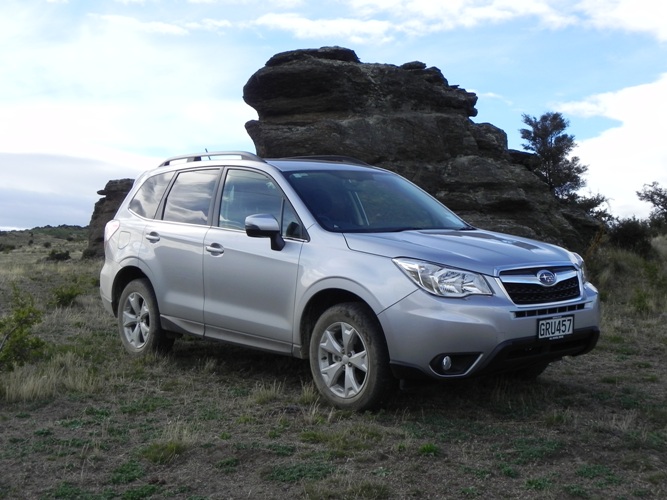
Car reviews
Read our expert car reviews - where we give insight into the latest vehicles to hit our roads.
21 March 2013
The new Forester has a sharp entry-price point that's going to attract buyers looking for a competent AWD SUV to suit New Zealand’s outdoor lifestyle. It’s just a shame there’s no automatic diesel which so many of the competitors offer these days.

With a bolder appearance at the front thanks to the new honeycomb grille, re-shaped bumpers and a raised bonnet, Subaru’s 2013 Forester has increased in length by 35 mm and the wheelbase has gained 25 mm. Forward vision has improved by moving the side mirrors from the A-pillars to the doors and repositioning the A-pillars 200 mm forward.
The cabin area has a refined look and feel thanks to the uncluttered dashboard and good quality materials that have been used throughout.
Subaru's Eyesight technology, which was introduced to the New Zealand market towards the end of 2012 on the Outback and Legacy, has been introduced into the new Forester as standard equipment on the XT and Premium models.
Subaru’s Eyesight system uses two forward facing stereo cameras, located on either side of the rear-view mirror, to detect and recognise objects in the vehicle’s path. Eyesight is like another set of eyes, peering over your shoulders, waiting to detect an imminent crash and alert the driver or apply the brakes if the driver doesn’t respond to the warnings.
Besides motor vehicles, Eyesight can also recognise pedestrians, motorcycles and cyclists. Other features of Eyesight include Adaptive Cruise Control, Lane Departure Warning, Vehicle Sway Warning and Lead Vehicle Start Alert.
We test drove the new Forester in the Otago region on tar-sealed surfaces, up mountains on rural dirt tracks, and on rocky stretches with fords and undulations, and found the ride was compliant both on and off the sealed surfaces.
The symmetrical AWD system distributes the power to the wheels with the most traction, for a sure footed ride, and in the twisty stuff the active stability feature does its best to prevent the rear of the vehicle from drifting off track.
The flat-four engine, with its low centre of gravity minimizes the effects of body roll associated with vehicles that have a high stance. A McPherson strut independent suspension is fitted up front while the rear has a double wishbone setup. Ground clearance isn’t too bad either, with a 220 mm ride height, the Forester tackles rough and tumble surfaces with ease.
Subaru has introduced it’s new 2.0L DIT (Direct Injection Turbo) engine to the Forester range. It’s a development of the motor that's fitted to the sporty BRZ with the main changes being a turbocharger and a direct injection fuel delivery system which has significantly improved performance; this is also the first time Subaru has used direct injection on a forced induction motor.
Four engines are on offer; a normally aspirated 2.0L petrol engine with 110kW/198Nm, a turbocharged 2.0L petrol motor developing hot-hatch output figures of 177kW/350Nm which is claimed to sprint from 0-100km/h in 7.6 seconds, a 2.0L diesel with 108kW/350Nm and the 2.5L petrol engine delivering 126kW/235Nm.
The four-speed automatic gearbox, fitted to the outgoing model, has been dropped and instead, the 2.0L turbo and 2.5L models use Subaru’s Lineartronic automatic (CVT) transmission. Manual shifters aren't popular in our market but for those drivers who still prefer three pedals, the oil burner and 2.0L normally-aspirated petrol variants are fitted with six-speed stick shifters.
Subaru’s new X-Mode is fitted to the auto models and assists drivers with negotiating low-adhesion surfaces as well as featuring Hill-Decent Control. When activated, the system manages the engine throttle, the AWD system and the brakes, for a controlled drive at speeds of up to 40km/h.
Subaru has fitted a stop/start system to all but the diesel and XT models, which along with the Lineartronic transmission has improved the fuel economy by 12.9%. Fuel consumption for the 2.0L engines are claimed at 5.9L/100km for the diesel and 7.2L/100km for the normally aspirated petrol, while the turbo model is claimed at 8.5L/100km. The 2.5L engine has a fuel economy of 8.1L/100km.
Active safety features include Electronic Stability Control (ESC), Electronic Brakeforce Distribution (EBD), Brake Assist and Traction Control System (TCS).
The Forester has been awarded a five-star ANCAP safety test result and passive safety features are in the form of seven airbags, a driver's knee airbag, frontal and side airbags for both front row seats and two curtain airbags.
Pricing kicks off at $39,990 for the 2.0L petrol while the diesel model adds $10k to the price tag. The 2.5L pricing starts at $44,990 up to $54,990 for the 2.5L Premium. The top of the range 2.0L Turbo XT model is priced at $59,990.
The new Forester has a sharp entry-price point that's going to attract buyers looking for a competent AWD SUV to suit New Zealand’s outdoor lifestyle. It’s just a shame there’s no automatic diesel which so many of the competitors offer these days.